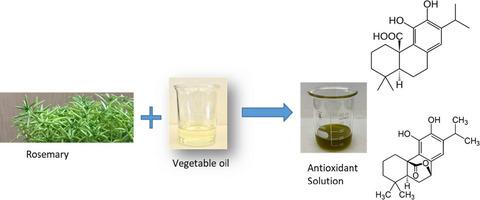当前位置:
X-MOL 学术
›
Int. J. Food Sci. Tech.
›
论文详情
Our official English website, www.x-mol.net, welcomes your
feedback! (Note: you will need to create a separate account there.)
Extraction of lipid‐soluble antioxidants from rosemary leaves using vegetable oils
International Journal of Food Science & Technology ( IF 2.6 ) Pub Date : 2020-04-07 , DOI: 10.1111/ijfs.14577 Shoshana R. Ginsburg 1 , Farnaz Maleky 1
International Journal of Food Science & Technology ( IF 2.6 ) Pub Date : 2020-04-07 , DOI: 10.1111/ijfs.14577 Shoshana R. Ginsburg 1 , Farnaz Maleky 1
Affiliation

|
The objective of this research was to extract carnosic acid and carnosol, natural lipid‐soluble antioxidants, from rosemary leaves without the use of chemical aid. Three different vegetable oils [high oleic soybean oil (HOSO), peanut oil (PO) and cottonseed oil (CO)] were used as the medium for extracting rosemary's lipid‐soluble antioxidants. Dried rosemary leaves were ground into fine particles, added two of the selected vegetable oils, mixed and heated. The vegetable oil containing the extracted antioxidants was filtered from the rosemary particles and analysed using high‐performance liquid chromatography (HPLC). As a control, a common extraction method using ethanol was performed to compare the oil extraction efficiency for carnosic acid and carnosol. HPLC analysis confirmed the presence of carnosic acid and carnosol in all three vegetable oil solutions. Compared to the ethanol extraction, a higher level of the carnosic acid was found in the vegetable oil solutions. Among the vegetable oils, high oleic soybean oil contained the most carnosic acid; however, there were similar amounts of carnosol in all three vegetable oil solutions. The extractions' efficacy was tested on soybean oil's (SO) oxidative stability by adding 2% (w/w) of the antioxidant–vegetable oil solution. The results obtained from peroxide value (PV) and p‐anisidine value (AnV) analysis documented a significantly lower degree of oxidation in the soybean oil containing the extracted antioxidant solutions, compared to the pure soybean oil.
中文翻译:

使用植物油从迷迭香叶中提取脂溶性抗氧化剂
这项研究的目的是在不使用化学助剂的情况下从迷迭香叶中提取肌酸和肌醇,即天然脂溶性抗氧化剂。三种不同的植物油[高油酸大豆油(HOSO),花生油(PO)和棉籽油(CO)]被用作提取迷迭香脂溶性抗氧化剂的介质。将迷迭香干叶磨成细颗粒,加入两种选定的植物油,混合并加热。从迷迭香颗粒中过滤出含有提取的抗氧化剂的植物油,并使用高效液相色谱(HPLC)进行分析。作为对照,使用乙醇的常用提取方法进行了比较,以比较肌酸和肌醇的油提取效率。HPLC分析证实在所有三种植物油溶液中均存在肌酸和肌醇。与乙醇提取相比,在植物油溶液中发现了更高含量的肌酸。在植物油中,高油酸大豆油含有最多的肌酸。但是,三种植物油溶液中的鼠尾草酚含量均相似。通过添加2%(w / w)的抗氧化剂-植物油溶液,对提取物的功效进行了大豆油(SO)氧化稳定性的测试。从过氧化物值(PV)和 在所有三种植物油溶液中,鼠尾草酚的含量均相似。通过添加2%(w / w)的抗氧化剂-植物油溶液,对提取物的功效进行了大豆油(SO)氧化稳定性的测试。从过氧化物值(PV)和 在所有三种植物油溶液中,鼠尾草酚的含量均相似。通过添加2%(w / w)的抗氧化剂-植物油溶液,对提取物的功效进行了大豆油(SO)氧化稳定性的测试。从过氧化物值(PV)和对茴香胺值(AnV)分析表明,与纯大豆油相比,含有提取的抗氧化剂溶液的大豆油中的氧化度明显更低。
更新日期:2020-04-07
中文翻译:

使用植物油从迷迭香叶中提取脂溶性抗氧化剂
这项研究的目的是在不使用化学助剂的情况下从迷迭香叶中提取肌酸和肌醇,即天然脂溶性抗氧化剂。三种不同的植物油[高油酸大豆油(HOSO),花生油(PO)和棉籽油(CO)]被用作提取迷迭香脂溶性抗氧化剂的介质。将迷迭香干叶磨成细颗粒,加入两种选定的植物油,混合并加热。从迷迭香颗粒中过滤出含有提取的抗氧化剂的植物油,并使用高效液相色谱(HPLC)进行分析。作为对照,使用乙醇的常用提取方法进行了比较,以比较肌酸和肌醇的油提取效率。HPLC分析证实在所有三种植物油溶液中均存在肌酸和肌醇。与乙醇提取相比,在植物油溶液中发现了更高含量的肌酸。在植物油中,高油酸大豆油含有最多的肌酸。但是,三种植物油溶液中的鼠尾草酚含量均相似。通过添加2%(w / w)的抗氧化剂-植物油溶液,对提取物的功效进行了大豆油(SO)氧化稳定性的测试。从过氧化物值(PV)和 在所有三种植物油溶液中,鼠尾草酚的含量均相似。通过添加2%(w / w)的抗氧化剂-植物油溶液,对提取物的功效进行了大豆油(SO)氧化稳定性的测试。从过氧化物值(PV)和 在所有三种植物油溶液中,鼠尾草酚的含量均相似。通过添加2%(w / w)的抗氧化剂-植物油溶液,对提取物的功效进行了大豆油(SO)氧化稳定性的测试。从过氧化物值(PV)和对茴香胺值(AnV)分析表明,与纯大豆油相比,含有提取的抗氧化剂溶液的大豆油中的氧化度明显更低。











































 京公网安备 11010802027423号
京公网安备 11010802027423号